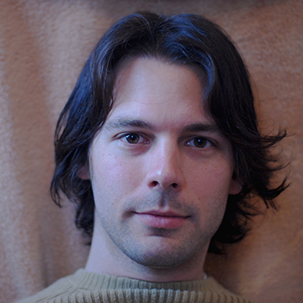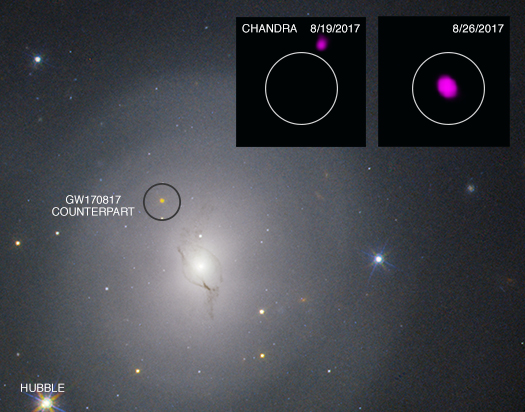Two Neutron Stars + Gravitational Waves = A Black Hole

Dave Pooley
It is a pleasure to welcome Dave Pooley as a guest blogger. Dave led the black hole study that is the subject of our latest press release. He is an associate professor at Trinity University in San Antonio, Texas, where he loves doing research with a cadre of amazing undergraduates on topics ranging from gravitational lensing to supermassive black holes to supernova explosions to exotic X-ray binaries to globular clusters. He lives in Austin with his wife, two (soon to be three) children, two cats, and one dog. When he’s not setting up train tracks, watching Daniel Tiger, or analyzing Chandra data, he enjoys cooking, woodworking, and all manner of whisky.
A colleague of mine at MIT once said that the minute the Laser Interferometer Gravitational Wave Observatory (LIGO) detects gravitational waves, it will be one of the most successful physics experiments ever performed, and the next minute, it will immediately become one of the most successful astronomical observatories ever operated.
He was exactly right. The direct detection of gravitational waves was a tremendous success for fundamental physics. We knew that gravitational radiation existed, but to directly detect it was huge. It was a triumph due to the meticulous and brilliant work of the hundreds of people who worked for years and years to make LIGO a success.
And immediately with that first detection, astronomers added gravitational waves to our tool belt of ways to study the universe. With just that first event, which was a merger of two black holes, we learned so much more about black holes than we previously knew. That, in turn, raised even more questions about these intriguing objects. Clearly, 60-solar-mass black holes exist. (That was news to us!) And you make them from 30-solar-mass black holes. (That was news to us too!) So 30-solar-mass black holes exist. (Even that was news to us, too!) But how do you make those? We astronomers have a few ideas, but we’re really not sure. We haven’t figured that out yet. Nature of course, already has.
Incidentally, that’s a lot of what astronomy and other branches of physics are all about — us trying to figure out what nature already knows how to do.
So it was clear from that very first LIGO detected event that we were going to learn a lot about black holes, which I thought was great because I heart black holes. Like many other astronomers, it wasn't clear to me how I would participate in and contribute to this new realm of astronomy. I’m an observer. Observers like to observe, hence the name. But the black hole mergers that LIGO detected didn't emit any electromagnetic radiation, and it’s not like I had my own gravitational wave detector in the basement. Still, even if I couldn't participate directly, it was thrilling to hear about each new LIGO black hole merger event.
I got the first whiff that something *really* exciting was about to be announced last fall when a colleague of mine sent Rai Weiss a note in September that he was sure to get the Nobel Prize in Physics, which was going to be announced on October 3rd 2017. Rai Weiss wrote back, "What could happen on Oct 3 is not as interesting as what you will hear about on Oct 16."
So this was going to be something even bigger than a Nobel Prize in physics?!?
That exciting event was GW170817, which was the merger of two neutron stars. One of the many really exciting aspects of that merger was that there were detectable electromagnetic signatures across the spectrum – radio, optical, and X-rays. Astronomers were ready to pounce on this with every available facility and telescope, and that's exactly what happened.
My colleagues and I read the initial round of papers on GW170817 with great interest. This was a historic moment in astronomy, and it was (and is) fascinating to contemplate in real time.
But one of the things that was not being addressed in the scientific literature was the one thing we were most interested in: what was the outcome of this merger? There were only two possibilities: a big neutron star or a small black hole. But which was it? Could we make any definite statement? Could we rule either one out? We set to work thinking about the implications and possible signatures of each one.
Pawan Kumar and Craig Wheeler, two eminent theorists, worked out the details for each scenario. I analyzed all available data and checked things over with Bruce Grossan, an all-around expert observer on many topics, including gamma-ray bursts. Bruce and I pored over the theoretical calculations that Pawan and Craig made. Craig and Pawan scrutinized the data analysis that Bruce and I performed. And we all wrote email to each other. Lots and lots of email. I mean, seriously, you would not believe the amount of email that four human astrophysicists can generate when they are this excited about something in the cosmos. This was an event we had never seen before — the merger of two neutron stars — and the four of us had something important to say about it! It was a *staggering* amount of email.
We came to the firm conclusion that there were striking differences in what we would see depending on what was left behind. Common to both scenarios was that a strong shock – akin to a sonic boom from a supersonic plane – was sent out into space around the merger. This shock would produce X-ray and radio emission that would get stronger for a while, and then fade away. That's all there would be in the black hole scenario. But if the merger left behind a neutron star, that neutron star would also produce emission, and that emission would get stronger and stronger with time such that it would have been clearly detectable as an additional source of radiation by now.
We haven't seen that. All we've seen is the emission get stronger and then start to fade. There's no sign of a neutron star there, so that merger must have made a black hole! So in addition to learning the outcome of the merger, we also learned that nature has another way to make black holes, other than supernova explosions of the most massive stars, and that's by merging neutron stars together. (Once again, this was news to us. Perhaps not very surprising news, but, still, this was the first time we actually observed it happening.) And on top of that we learn that there are some pretty small black holes out there. (Again, news to us.)
One of the most exciting things to think about is what else this event might show us. As we monitor it in the coming years, it may do something we never expected it to do — nature might show us yet another thing that it knows how to do that we don’t. That’s the kind of stuff astronomers live for. And if that does happen, I'll be ready for the next avalanche of emails.
Category:
- Log in to post comments


